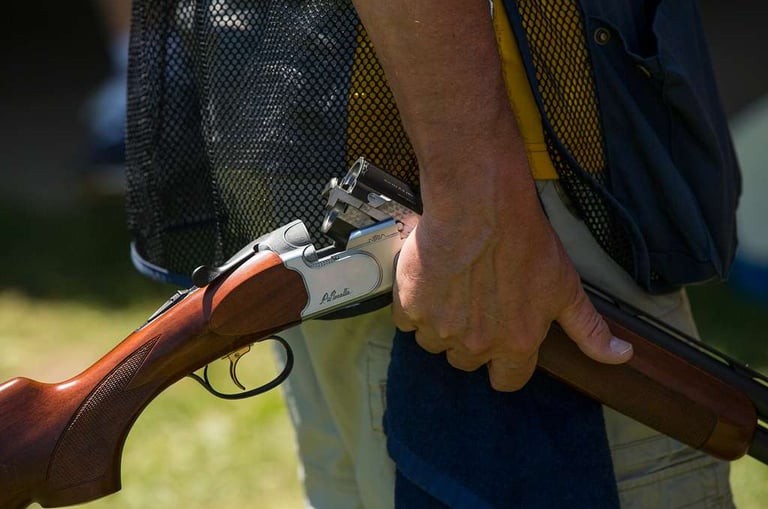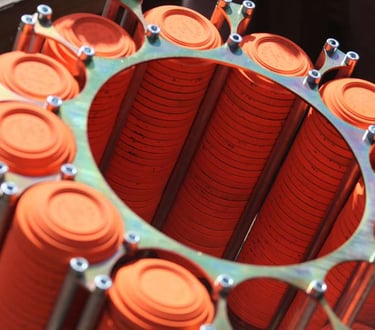Skeet Shooting: Getting Started with Clay Targets, Trap, and More
Discover the exciting world of skeet shooting, trap, and clay target sports. Tips, techniques, and insight from a father sharing the sport with his teenage son.
SPORTING CLAYS
Derringer Dan
7/5/20257 min read


Understanding Skeet Shooting and Clay Target Sports
Skeet shooting is one of the most rewarding and skill-building shooting sports you can get into—whether you’re a complete beginner or someone who’s been behind the sights for years. Lately, I’ve found myself spending weekends with my teenage son exploring the world of clay target shooting: skeet, trap, and good old-fashioned backyard clay busting. What started as a fun way to bond has turned into a deeper dive into one of shooting’s most classic disciplines.
If you’ve been thinking about getting into skeet shooting—or want to sharpen your skills—this guide breaks down the basics, the differences between skeet and trap, gear tips, and more.
What Is Skeet Shooting?
Skeet shooting is a competitive shooting sport where participants attempt to break clay discs flung into the air at high speed from two fixed stations: the high house and the low house. Shooters move through eight positions arranged in a semi-circle between the two towers. The paths of the clays cross, simulating birds in flight from different angles.
A typical round consists of 25 targets, with singles and doubles from various stations. Success depends on timing, smooth tracking, and precise shooting. It's fast-paced and tests your ability to react and lead a target.
Why Skeet?
Great for improving hand-eye coordination
Builds shooting rhythm and consistency
Accessible at most shooting clubs and ranges
A formal, regulated sport with competitions for all skill levels
Understanding Trap Shooting
While skeet targets fly across your field of view, trap shooting sends them away from you. In trap, the clay pigeons are launched from a single "house" directly in front of the shooter but at random angles—left, right, or straight out.
Trap tends to emphasize reaction time and focus on rising, retreating targets. It's a different kind of challenge, often requiring less horizontal swing and more vertical adjustment.
Trap Highlights:
Targets fly away unpredictably
Often preferred by hunters training for bird flushing
Commonly shot from 16 yards behind the launch house
Easier setup for casual backyard use with a manual thrower
Casual Clay Shooting: Just for Fun
Not all clay target shooting has to be formal. Many shooters enjoy simple clay pigeon shooting with handheld or mechanical throwers in rural areas, open fields, or private property (check local laws first). It’s a great way to get comfortable with your shotgun and practice without the structure of a formal range.
This is how my son and I started. We picked up a basic manual thrower and a few boxes of clays. It’s not as structured as skeet or trap, but it’s fun—and lets you ease into the rhythm of tracking and leading a moving target.
Gear Tip:
If you're practicing casually, start with a 12-gauge or 20-gauge shotgun and light target loads. Safety glasses, ear protection, and a proper shooting stance go a long way, even in casual settings.


Best Shotgun Types for Clay Shooting
As we’ve been getting more into shooting clays, I’ve looked into the different types of shotguns people use for sports like skeet, trap, and sporting clays. Here’s a quick breakdown of the most common ones you’ll come across and what makes each one unique:
Single-Shot Shotguns
These are about as simple as it gets—one shell at a time. Most are break-action, meaning you physically open the barrel to load and unload each shot. They're lightweight and often affordable, making them a good starter option. However, the lighter weight usually means more recoil, and since you only get one shot before reloading, they’re not the best fit for faster-paced clay shooting games that require quick follow-ups.
Over/Under Shotguns (O/U)
This style has two barrels stacked vertically, giving you two shots without needing to reload. Many of these have a single trigger that alternates barrels, though some use two triggers. Over/unders are widely used in competitive shooting and come in different builds:
Trap models tend to be heavier with longer barrels (30"–32") and tighter choke patterns, aimed slightly high to match rising targets.
Skeet versions are usually lighter and more maneuverable, with shorter barrels (26"–28") and more open chokes for quick target acquisition.
Sporting models often allow for interchangeable chokes and come in various barrel lengths to suit different preferences.
Side-by-Side Shotguns (SxS)
These shotguns have barrels positioned next to each other. While they have a classic look, many shooters—especially beginners—find them harder to aim. The wide profile doesn’t give the same intuitive sightline as a single-barrel gun. They're also less common these days, and many older models aren’t built to handle modern steel shot, which limits where they can be used.
Pump-Action Shotguns
These have a single barrel and are reloaded by sliding the forearm back and forth to cycle the next shell from a magazine. Pumps are common in the U.S., especially among casual shooters, but they're a bit slower for follow-up shots compared to other types. You’ll feel more recoil than with a semi-auto, and you’ll need a bit of rhythm to stay smooth on the range.
Semi-Automatic Shotguns
This is what we’ve been experimenting with lately. A semi-auto fires one shell per trigger pull and automatically loads the next round. They usually have softer recoil than pumps or single-shots, making them easier on the shoulder during long sessions. They're great for quick shooting and staying on target—ideal for sports like skeet where speed and rhythm really matter.
The Guns We Use (and Why)
A lot of people ask what shotgun is best for clay shooting, and honestly, the answer depends on your preference and budget. My son and I have been using a Mossberg Silver Reserve over/under (12 GA.). Affordable, durable, and great for learning the ropes. And the H&R 1871 Pardner Pump Protector (20 GA.) which was originally purchased to be kept at the bedside but has graduated to our range time companion.
Other Popular options on the range include:
Remington 870 – classic, reliable pump-action
Mossberg 500 – versatile and affordable
Beretta A300 or A400 – higher-end semi-auto with soft recoil
CZ Drake Over/Under – a solid value for traditionalists
Targets/ Clays
Clay targets, often called “clays” or “birds,” are specially designed discs made from a mix of pitch and crushed limestone. Shaped like upside-down saucers, they’re built to withstand the impact of being launched at high speeds—but they’ll still shatter easily when hit by just a few well-placed shotgun pellets. Most are bright orange for visibility, but other colors like white or yellow are also used depending on the lighting and background to help shooters track them in flight.


These targets come in a few different types and sizes. The standard version used in American trap, skeet, and sporting clays is 108 mm in diameter, while international competitions use a slightly larger 110 mm version. There are also smaller and specialty types: “midis” (90 mm) fly faster, “minis” (60 mm) are tiny and tricky, and “battue” targets are ultra-thin, flying fast before suddenly dropping—mimicking birds like ducks. There are even “rabbit” targets designed to roll along the ground, and wild “ZZ” birds that zip through the air unpredictably thanks to a spinning propeller. Most modern ranges use automated throwers to launch clays consistently, but hand-throwers and manual slings are still popular for casual or trick shooting.
Where to Shoot Clays: Local Ranges and DIY Setups
As we’ve started exploring the world of clay target shooting more seriously, we’ve come across a few local ranges that cater to different levels of experience. One nearby range offers a full skeet field with automated launch houses, which makes for a smooth experience—ideal for those looking to practice under true skeet conditions.
Another spot we’ve visited is a bit more casual. It doesn’t have fixed towers or an automated setup, but it does allow you to bring your own clay thrower and use their open field. This has opened up a lot of possibilities for us as we’re starting to experiment with personal launchers and shooting on our own terms.
If you’re not near a full-service range, don’t worry. Many shooters get started (or continue practicing) with home setups or informal rural spots—always making sure it's legal and safe to do so in the area.
Choosing a Trap/ Clay Launcher: Manual to Automatic
Getting into clay shooting doesn’t require a huge budget. One of the easiest and most affordable ways to start is with a handheld clay thrower—basically a long plastic arm that lets you fling clays with your own strength. It takes a bit of practice, but it’s cheap, portable, and fun.
From there, the next step up would be spring-loaded mechanical launchers, which can be anchored into the ground and pulled with a string. These offer consistent throws and allow solo practice without too much hassle.
For those ready to invest more, there are automatic electric launchers that can hold stacks of clays (20 to 50+), come with wireless remotes, and offer adjustable angles. These are ideal for more serious shooters or anyone who plans to shoot often and wants to simulate more advanced scenarios like crossing, outgoing, or incoming targets.
Clay Launcher Options:
Handheld throwers – low cost, great for beginners
Manual spring-loaded throwers – better consistency, low-to-mid cost
Automatic launchers – advanced features, higher cost but long-term value
We’ve been exploring options ourselves, and we’re leaning toward picking up a mid-range single-clay launcher with remote activation. It’s a good balance of convenience and affordability—and perfect for father-son outings without relying on a full-blown range every time.
Skeet shooting, trap, and casual clay shooting all offer their own unique challenges and rewards. Whether you’re training for competition, brushing up on bird-hunting skills, or simply bonding with family and friends over flying clays, there’s something undeniably satisfying about watching a disc explode mid-air from a perfect shot.
As for me, this journey is just beginning. Sharing the experience with my son has added another layer of enjoyment—and I look forward to documenting more of what we learn, the gear we try, and the memories we make along the way. Whether you’re just starting out or a seasoned shooter, there’s always more to learn in the world of clay targets... So Stay tuned!
Subscribe newsletter
or Email us at: DerringerDan@Snakebite.com
For Advertising information: 941-876-8332
425 Montague ln. Northport, FL 34287
